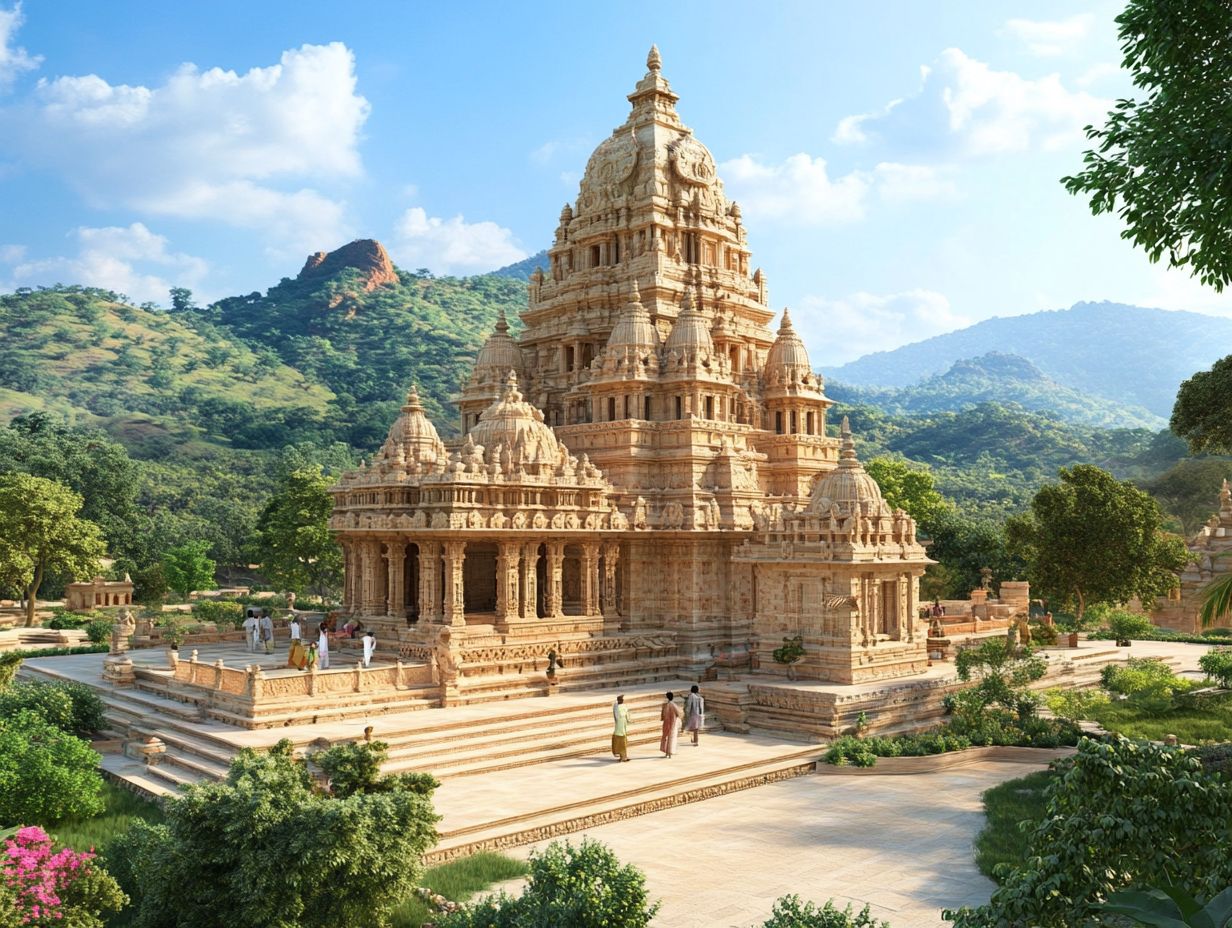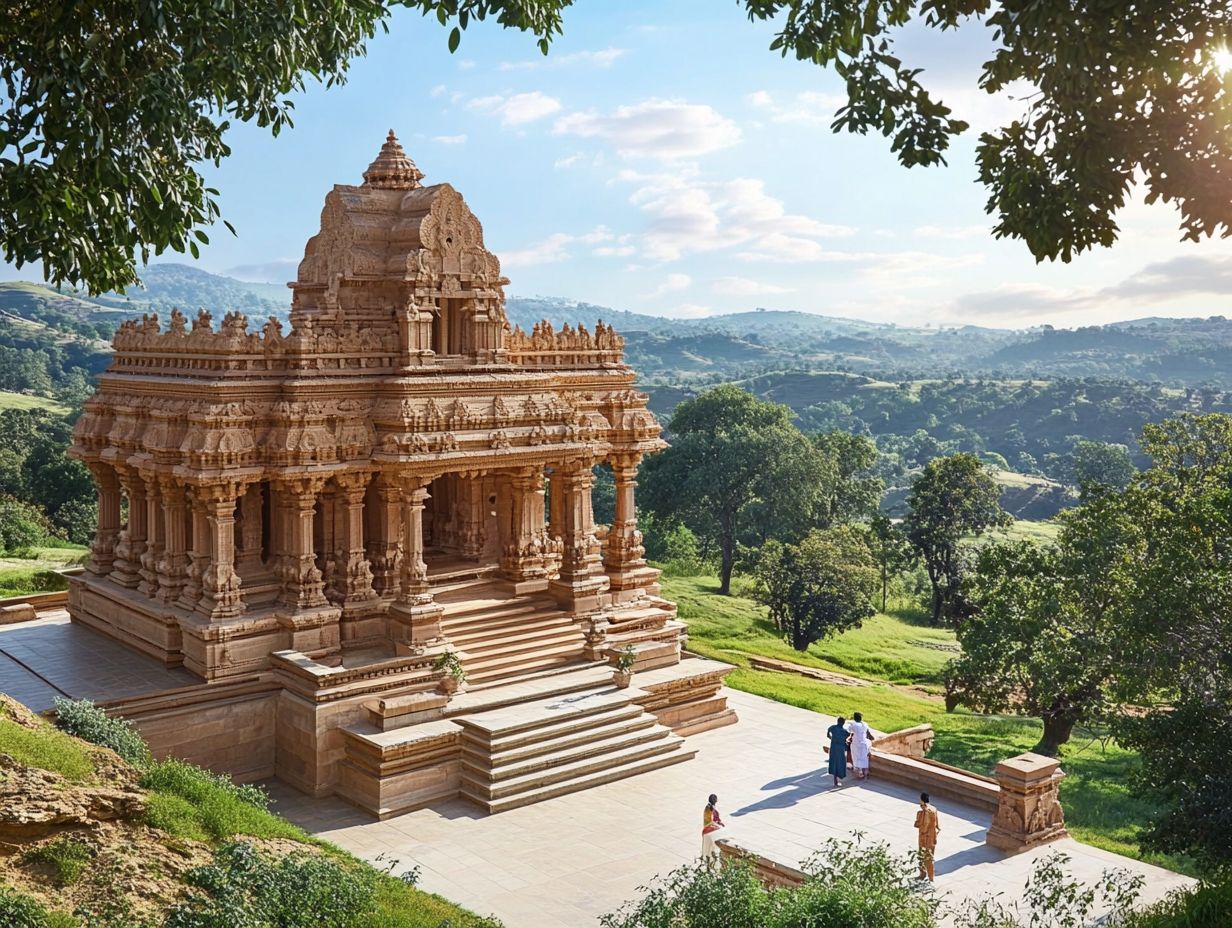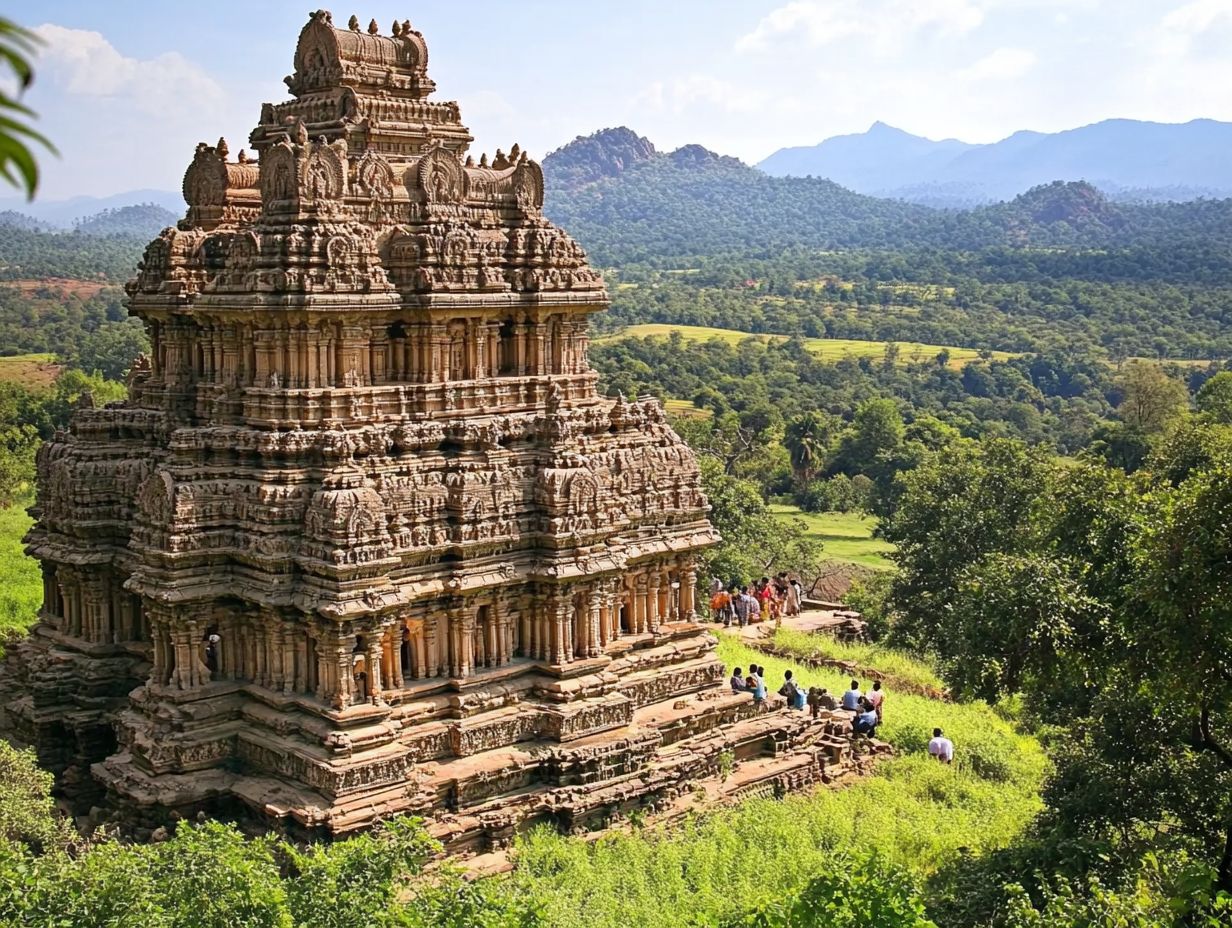Why Didn’t Hinduism Spread?
Hinduism stands as one of the world s oldest religions, woven into the very fabric of Indian society for millennia, characterized by a rich array of beliefs, rituals, spiritual practices, and historical contexts.
This article delves into the origins and development of Hinduism, charting its evolution from the Vedic period through the Gupta Empire. It also investigates the various factors that have impeded its expansion, such as the influences of Buddhism and Jainism, foreign invasions, colonialism, and the enduring presence of indigenous religions.
In examining the growth and spread of Hinduism, a comparison is drawn with the trajectories of Christianity, Islam, and Buddhism, illuminating the intricate complexities of its historical context and cultural exchanges.
The exploration seeks to unravel the detailed history of Hinduism and position it within the larger tapestry of global religions, highlighting its role in religious pluralism and interfaith relations.
History of Hinduism

The history of Hinduism presents a complex narrative that unfolds over thousands of years, intricately rooted in the Indian subcontinent. It is distinguished by a multitude of belief systems, a rich cultural heritage, and a diverse array of rituals, festivals, and practices.
Emerging from the ancient Vedic traditions, Hinduism has undergone significant evolution shaped by various historical contexts, socio-political dynamics, migrations, and cultural exchanges that have contributed to its distinctive identity. To understand the propagation of this rich tradition, one can explore how Hinduism spread in India. Its development showcases a harmonious blend of indigenous beliefs and external influences, skillfully navigating geographical boundaries, colonial challenges, and demographic trends to forge a unique religious identity.
Furthermore, Hinduism’s historical evolution is characterized by remarkable adaptability, allowing it to thrive in an increasingly globalized world that values interfaith dialogue, religious freedom, and pluralism.
Origins of Hinduism
The origins of Hinduism can be traced back to the ancient practices and philosophical traditions of the Indian subcontinent, primarily documented in sacred texts such as the Vedas, Upanishads, and the Bhagavad Gita, which serve as foundational pillars of this rich religion.
These texts encapsulate not only the rituals, hymns, and moral guidelines that have influenced millions of followers over the centuries, but they also explore profound metaphysical inquiries and existential questions that shaped early Indian thought. The Vedas, comprising four distinct collections, offer valuable insights into the socio-religious landscape of ancient society, underscoring rituals that were integral to various ceremonies, from agricultural rites to governance.
In contrast, the Upanishads signify a pivotal shift towards spiritual philosophy, placing a strong emphasis on the pursuit of knowledge and the journey of self-realization. Collectively, these texts weave a complex tapestry of indigenous beliefs and practices that inform the core teachings and diverse expressions of this enduring tradition.
Development of Hinduism
The evolution of Hinduism epitomizes a dynamic interplay of cultural diffusion, historical contexts, and philosophical development, resulting in a rich tapestry of practices, sectarian movements, and a sophisticated social structure that encompasses a vast spectrum of beliefs, regional variations, and traditions.
Beginning with the Vedic period, when sacred texts such as the Vedas and Upanishads established foundational philosophies, Hinduism has continuously evolved through various epochs. Each stage has contributed additional layers to this ancient faith, from the rise of regional deities to the intricate caste system that defines its social fabric, and the impact of colonialism and modern challenges in shaping contemporary Hindu identity.
Significant milestones, such as the emergence of the Bhakti movement, introduced personal devotion, transforming spiritual experiences into deeply personal journeys. Various sects, including Shaivism and Vaishnavism, expanded the pantheon of deities, while influential thinkers like Adi Shankaracharya and Ramanuja presented philosophical paradigms such as Advaita and Vishishtadvaita. Moreover, practices like meditation and yoga have become integral aspects of Hindu spiritual philosophy.
This intricate evolution illustrates how Hinduism has adapted to cultural exchanges and societal shifts, consistently reshaping itself to maintain relevance in the contemporary world, particularly in the contexts of modernization, globalization, and secularism.
Spread of Hinduism in India
The evolution of Hinduism in India unfolds as a captivating narrative, distinguished by its remarkable resilience in the face of geographical obstacles, historical invasions, political factors, and the profound cultural exchanges that have influenced its development.
Its origins can be traced back to the fertile plains of the Indian subcontinent, where it thrived across various epochs, continuously adapting and transforming throughout the ages.
Spread of Hinduism during the Vedic Period
During the Vedic Period, Hinduism intricately established its foundational beliefs and rituals, paving the way for its expansion across the Indian subcontinent, primarily through the oral transmission of the Vedas and the cultural diffusion of its core philosophies. This period also saw the establishment of social hierarchy through the caste system.
The Vedic texts, crafted between 1500 and 500 BCE, represent a rich tapestry of hymns, rituals, and philosophical discourse that permeated society at every level. These scriptures not only delineated liturgical practices but also instituted a complex social hierarchy, encapsulated by the varna system, which categorized individuals according to their duties and responsibilities. This system later evolved into the more rigid caste system.
Rituals, such as yajnas (sacrificial ceremonies), played a pivotal role in this spiritual landscape, cultivating a sense of community and devotion among practitioners. The comprehensive commentary on dharma, or moral order, significantly influenced ethical conduct, ensuring that the principles of Hinduism infused various aspects of daily life, thus solidifying its dominance in the region.
Spread of Hinduism during the Gupta Empire

The Gupta Empire signifies a pivotal chapter in the history of Hinduism, marked by a flourishing of the religion alongside a remarkable cultural exchange that accelerated its dissemination through political patronage and a profound commitment to religious tolerance and syncretism.
During the Gupta reign, the arts experienced an unprecedented renaissance, as temples emerged as vibrant cultural hubs. These sacred spaces showcased exquisite sculptures and lively frescoes, vividly portraying a pantheon of deities and scenes from revered Hindu epics such as the Ramayana and Mahabharata.
This era also witnessed the flourishing of Sanskrit literature, with poets and playwrights drawing inspiration from Hindu themes, resulting in works that captivated both the elite and the general populace.
The proliferation of temples throughout the empire not only reinforced the performance of Hindu rituals but also fostered a strong sense of community, intertwining spirituality with daily life. This synthesis ultimately solidified Hinduism’s status as a fundamental pillar of Gupta society, with Hindu temples serving as cultural and educational institutions.
Impact of Hinduism in Indian Society
Hinduism has significantly influenced Indian society, intricately shaping its social structure through the caste system, community practices, and a vibrant array of traditions, festivals, and family structures that continue to resonate with millions.
This ancient religion provides a framework for social hierarchy and roles, with the caste system, categorized into various groups, determining not only individual professions but also the dynamics of interactions and relationships within the community. Family structures reflect a unique blend of patriarchal norms and a strong emphasis on collective harmony, embodying values that prioritize familial duty and societal commitments, such as rituals and customs upholding social cohesion.
Community life, enriched by festivals, rituals, and shared celebrations, cultivates a profound sense of belonging and unity among individuals, reinforcing traditional customs that have been preserved through generations. Together, these elements vividly illustrate how Hinduism shapes perceptions of identity and social connectivity within Indian society, fostering a worldview that emphasizes ethical considerations and social harmony.
Factors that Hindered the Spread of Hinduism
While Hinduism thrived across various regions, its expansion faced several impediments. The emergence of Buddhism and Jainism, foreign invasions, and resistance from indigenous beliefs all played significant roles in shaping the intricate religious landscape of the Indian subcontinent.
These factors collectively influenced the trajectory of Hinduism’s spread and development in the region.
Influence of Buddhism and Jainism
The influence of Buddhism and Jainism on Hinduism is distinctly significant, as both religions presented alternative belief systems that resonated with many individuals, resulting in notable patterns of conversion and a transformation of the religious dynamics of the era. Additionally, the rise of Sikhism further diversified the religious landscape of the Indian subcontinent, contributing to the rich fabric of inter-religious dialogue and syncretism.
These emerging philosophies placed a strong emphasis on individual spiritual development and ethical living, presenting a striking contrast to the ritualistic practices and caste hierarchy typically associated with Hinduism. Buddhism, founded by Siddhartha Gautama, centered on the Four Noble Truths and the Eightfold Path, which offered followers a roadmap toward enlightenment and liberation from suffering. In contrast, Jainism, anchored by its core principle of non-violence (ahimsa), garnered the interest of those disillusioned with ritual sacrifices, advocating for a lifestyle rooted in asceticism and truthfulness.
This philosophical divergence not only provided alternative avenues for spiritual fulfillment but also fostered dialogue and tension among the communities, thereby enriching the complex tapestry of Indian religiosity. In response to these evolving moral landscapes, Hindu practices began to adapt, reflecting the broader shifts in spiritual thought and ethical considerations.
Foreign Invasions and Conversions
Foreign invasions profoundly influenced the proliferation of Hinduism, introducing a multitude of challenges and resulting in conversions that altered the socio-political landscape of the Indian subcontinent.
These incursions brought with them diverse ideologies and religious practices, compelling a reassessment of both individual and collective identities within the region. Encounters with an array of cultures often precipitated syncretism, wherein distinctive elements of Hindu beliefs were assimilated into the practices of the invaders, and vice versa.
Over time, this fusion engendered hybrid forms of worship and devotion, thereby complicating the existing religious framework.
The ensuing transformations compelled individuals and communities to navigate their spiritual affiliations with great care, influencing how they defined themselves in relation to foreign dominators and among each other. This dynamic ultimately reshaped the essence of what it meant to be Hindu in an ever-evolving world.
Resistance from Indigenous Religions

Resistance from indigenous religions significantly influenced the spread of Hinduism, as these belief systems often held strong cultural roots that contested the adoption of Hindu practices.
The intricate dynamics of this interaction reveal how local traditions have exhibited remarkable resilience through the centuries. As Hinduism ventured into various regions, it encountered a rich tapestry of indigenous beliefs, deeply embedded in the cultural fabric of these communities. Instead of merely absorbing Hindu practices, many indigenous faiths adapted and transformed elements of Hinduism to align with their own narratives, resulting in the emergence of syncretic forms of spirituality.
This blending of traditions not only underscores the enduring strength of local customs but also emphasizes the agency of indigenous peoples in shaping their spiritual identities in response to external influences.
Comparison with Other Major Religions
The examination of Hinduism alongside other prominent religions, including Buddhism, Christianity, and Islam, unveils noteworthy distinctions in beliefs, practices, and historical contexts.
This comparative analysis offers valuable insights into the rich and varied tapestry of global religious traditions.
Spread of Christianity
The spread of Christianity in India has encountered the deep-rooted foundations of Hinduism, resulting in intricate interactions that have shaped cultural exchanges and influenced conversion efforts through missionary activities.
This dynamic relationship traces back to the arrival of traders and missionaries as early as the first century, weaving a rich tapestry of belief systems that have intertwined over centuries. The initial encounters were characterized by a notable degree of tolerance, as early Christians adapted their practices to the local context, fostering a unique blend of traditions.
However, as Christian missions expanded, particularly during the colonial era, they encountered significant resistance from Hindu communities that were fiercely protective of their spiritual heritage. This interplay underscores not only the struggle for religious conversion but also the broader implications for social and cultural transformations, illuminating the narrative of coexistence and conflict within India’s diverse religious landscape.
Spread of Islam
The spread of Islam in India was characterized by historical invasions and the establishment of political authority, leading to significant conversion rates and profoundly influencing the socio-religious fabric of Hindu society.
With the arrival of Muslim rulers, new administrative structures and cultural practices were introduced, fostering interactions and exchanges between the Islamic and Hindu communities. These encounters were not merely confrontational; rather, they often featured syncretism and the blending of traditions, enriching the cultural milieu of the subcontinent.
Over the centuries, as traders, scholars, and travelers explored Indian territories, the teachings of Islam began to permeate local society, affecting religious identity. This resulting pluralism cultivated a rich tapestry of beliefs, where the coexistence of diverse faiths facilitated a dynamic dialogue that significantly shaped the Indian religious landscape.
Spread of Buddhism
The spread of Buddhism in India, often regarded as a rival ideology to Hinduism, catalyzed a significant cultural exchange and historical context that transformed the region’s religious landscape.
This movement was profoundly influenced by pivotal figures such as Siddhartha Gautama, known as the Buddha, whose teachings underscored compassion, meditation, and the pursuit of enlightenment. As Buddhism gained momentum, it posed a challenge to the established Hindu orthodoxy, fostering a dynamic interaction between the two faiths. This ensuing dialogue prompted modifications within both belief systems, particularly regarding rituals and philosophical tenets.
The support of influential rulers, notably Emperor Ashoka, played a crucial role in disseminating Buddhist ideas across Asia, further intertwining these religions and highlighting the remarkable impact of cultural exchange on their evolution. This intricate relationship ultimately contributed to shaping the diverse spiritual tapestry of India.
Frequently Asked Questions

Why didn’t Hinduism spread to other parts of the world?
There are multiple factors that contributed to the limited spread of Hinduism outside of the Indian subcontinent, including the complex and diverse nature of the religion, the strong cultural and societal ties to Hindu traditions, and the lack of organized missionary efforts.
Did Hinduism have any contact with other religions?
Yes, Hinduism has had contact with various religions throughout history, including Buddhism, Jainism, and Sikhism. However, these religions also originated in India and share many cultural and philosophical similarities with Hinduism.
Was there any resistance to the spread of Hinduism?
Yes, there were often conflicts and resistance to the spread of Hinduism, particularly in regions where it clashed with other dominant religions or cultures. This was also due to the strict caste system and the belief in karma, which limited social mobility and conversion.
Why is Hinduism considered a way of life rather than just a religion?
Hinduism encompasses a vast array of beliefs, practices, and cultural traditions that are deeply ingrained in the daily lives of its followers. It is not just a set of religious rituals, but also influences social, cultural, and political aspects of daily life.
How did Hinduism spread within India?
Hinduism’s spread within India can be attributed to the lack of a centralized religious authority, allowing for a diversity of beliefs and practices to coexist. Additionally, the incorporation of local customs and traditions into Hinduism made it more accessible and relevant to different regions.
Is Hinduism still growing today?
Yes, Hinduism continues to grow in terms of followers, particularly in countries such as Nepal, Bangladesh, and Indonesia. However, conversion to Hinduism is not actively promoted, and growth mainly occurs through birth and cultural transmission.
